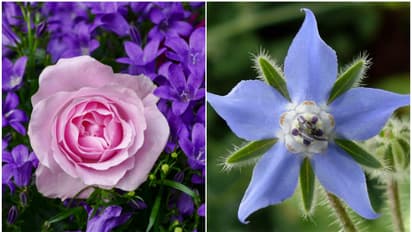Borage to Rose: Know these 7 edible flowers and their benefits
Edible flowers add color, flavor, and creativity to dishes, ranging from salads to desserts. Many blooms not only enhance the visual appeal of food but also provide subtle tastes, from floral to spicy notes. Incorporating edible flowers can elevate both the flavor and presentation of any meal

Edible flowers have been used in culinary traditions across cultures for centuries. These blossoms offer a delightful blend of visual appeal and unique flavors, transforming simple dishes into gourmet experiences. From garnishing desserts to adding delicate hints to savory dishes, edible flowers like lavender, nasturtiums, and violets bring a fresh, natural touch. Besides being aromatic, many of these flowers are packed with nutrients, offering both beauty and health benefits in a plate of food
Lavender’s sweet, floral fragrance makes it a popular choice for baked goods, teas, and salads. Its light, herbaceous flavor complements desserts, especially cakes, cookies, and ice creams. Lavender also pairs well with savory dishes, adding a delicate balance to meats and roasted vegetables. Rich in antioxidants, it can help promote relaxation when used in infusions. Due to its strong flavor, it's best to use lavender sparingly to avoid overwhelming a dish
Known for its vibrant colors, nasturtium has a peppery, mustard-like taste, similar to arugula. The entire plant is edible, from the leaves to the flowers, and it works wonderfully in salads, sandwiches, and even as a garnish for soups. Its bright, tangy flavor adds zest to any meal, and it pairs well with cheeses, meats, and vinaigrettes. Nasturtiums are also high in vitamin C and act as a natural immune booster, making them not only flavorful but also nutritious
Roses are not only beautiful but also highly versatile in cooking. The petals have a sweet, slightly spicy flavor and are used in syrups, jams, and desserts. Rose water, made from steeping the petals, is popular in Middle Eastern and Indian cuisines, particularly in sweets. The petals can be added to salads or infused into honey or vinegar. Rose hips, the fruit of the rose plant, are also edible and rich in vitamin C, offering both culinary and medicinal benefits
Chamomile, a daisy-like flower, is best known for its calming properties, often consumed as a tea to help with sleep and relaxation. Its mild, apple-like flavor makes it a great addition to baked goods and infusions. Chamomile can be used in syrups, desserts, and salads. When steeped, it releases essential oils that are beneficial for digestion and soothing the nerves. This delicate flower is also popular for making infused oils and honey
Borage flowers, with their striking blue color, have a mild cucumber-like taste. They are often used to garnish salads, soups, or drinks, especially summer beverages like lemonade. The flowers are also used in herbal teas. Borage is known for its anti-inflammatory properties and is rich in essential fatty acids. It pairs well with light, refreshing dishes and adds a cooling element to savory meals. The plant's leaves are also edible, often used in soups
Hibiscus flowers, famous for their deep crimson color, have a tart, cranberry-like flavor. They are often used in teas, jams, and sauces, providing a burst of tartness. Hibiscus tea is rich in antioxidants and is known to help lower blood pressure. The petals can also be candied or added to desserts for a tangy twist. Besides their culinary uses, hibiscus is highly prized for its health benefits, including promoting digestion and helping regulate cholesterol levels
Violets are small, fragrant flowers that offer a sweet, floral flavor. They are often used to decorate desserts such as cakes, cookies, and ice creams. The petals can also be candied or used fresh in salads. Violets are rich in vitamins A and C, making them not only visually appealing but also nutritious. They work well when paired with fruity desserts or added to herbal teas for a light, fragrant touch. The leaves of violets can also be used in cooking